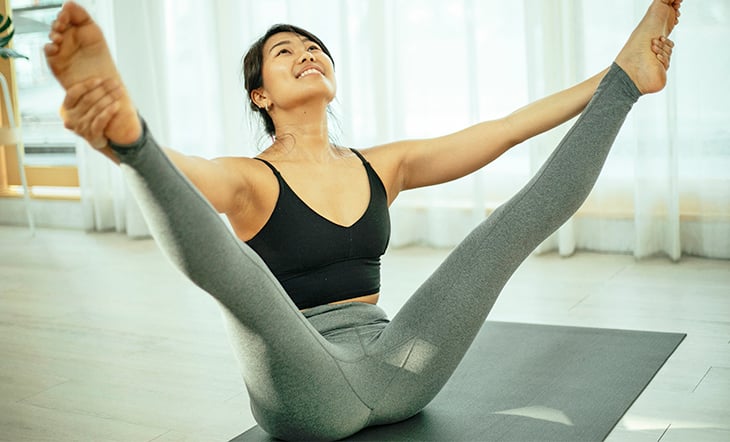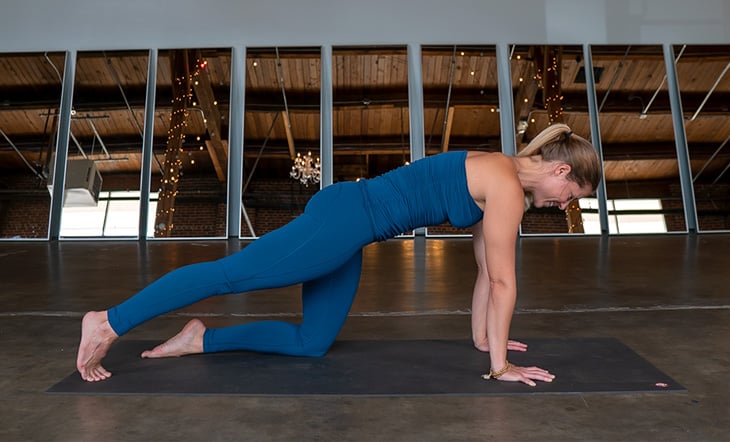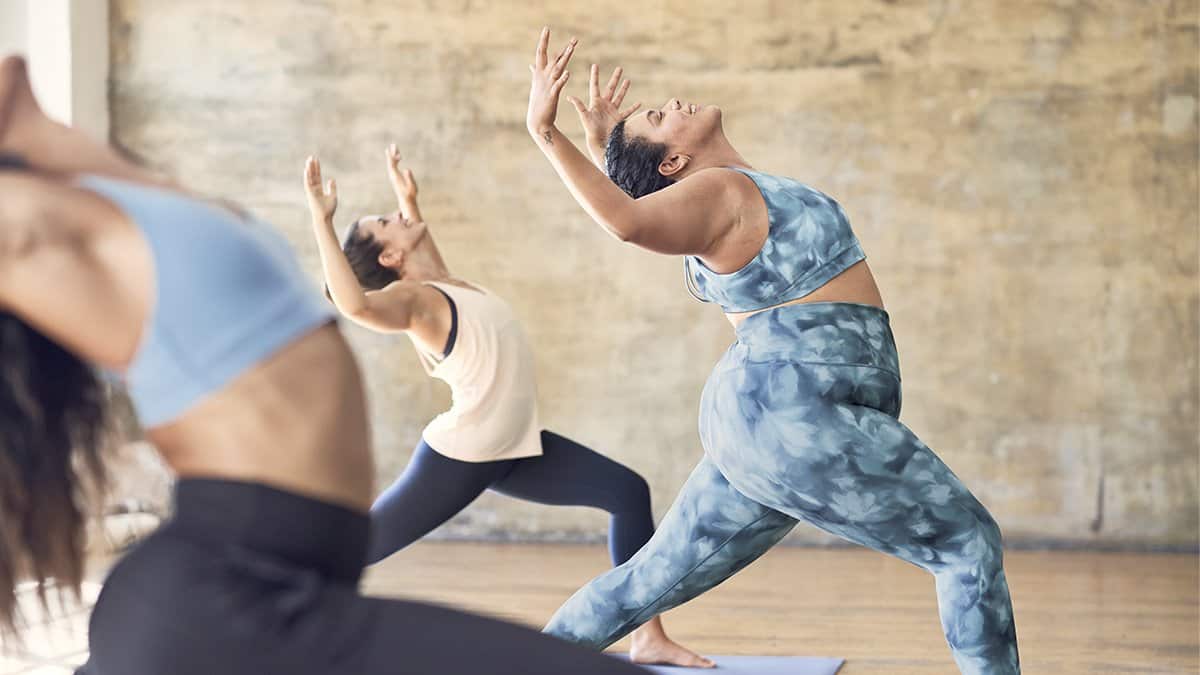Improve Any Yoga Pose With These 5 Alignment Cues
Whether you are a teacher, long time practitioner or stepping onto the mat for the first time, we can all “cue” our body to make subtle adjustments that may not even be visible to others. The time we spend...

Whether you are a teacher, long time practitioner or stepping onto the mat for the first time, we can all “cue” our body to make subtle adjustments that may not even be visible to others.
The time we spend on our yoga mat isn’t about making pretty shapes with our body though. Rather it’s about embodying the poses themselves and teaching us skills and tools to use for life when off the mat.
We learn these skills by being present, open, breathing intentionally and moving in a way that honors our body and the practice.
It doesn’t matter what level of experience you have – we can all do things to improve our experience while we’re practicing yoga poses. This “improving” doesn’t mean we make the pose look any better or more impressive.
Read on for our favorite foundational yoga cues that will help create a safer and sustainable practice that lasts beyond the time we spend on the mat.
Improve Any Pose With These 5 Foundational Yoga Cues:
If you’re ready to incorporate alignment cues that have real world applications off the mat, start here.
1. Find Your Breath
Thankfully, breathing is an automatic and involuntary process controlled by our brain. This allows us to live our lives and sleep at night without danger of not getting enough oxygen, or building up too much carbon dioxide.
But movement, emotions and stress can all impact the quality of our breath. At times of stress, either emotional or physical, we tend to take shallow breaths and use only a portion of our lungs capacity.
One of the core tools yoga gives us is breathwork. We start and end many yoga classes by lengthening our breath or controlling it with a specific technique.
But somehow, between the initial breathwork and the long hold in Camel Pose (Ushtrasana) we lose it. It’s not that we stop breathing completely, it just gets impaired or temporarily derailed.
Any asana (yoga pose), beginner or advanced, simple or complex, can all be improved and stabilized by intentionally breathing.
Visualize your lungs expanding like a balloon as you draw breath in, and then deflating with your exhale. Try sending breath deep into the lower lobes of your lungs using them to full capacity.
Apply this yoga cue off the mat:
Breathwork is perhaps the easiest yoga skill to apply off the mat. We can use different breathing techniques to meet our various needs. It can bring us energy to handle a hectic day, or calm us down to help us sleep at night.
We can use it to help release emotions, or to keep them at bay if needed for a more appropriate time. So find your breath, on and off the mat, and let the power of breath get you though.
2. Lengthen Your Spine
We spend much of our day hunched over. Between working jobs that keep us seated or sedentary, plopping in front of the television at night, or looking down at our phones to check up on the latest social media posts, we’ve trained our spine to stoop and compress.
Asana practice helps to counteract bad training and bad habits.
Whether you’re in a standing pose, balancing pose, backbending or enjoying a seated posture, it helps to lengthen the spine. You’ll want to lengthen without over straightening. Spines should have an “S” curve to them, and you want to maintain that while finding extra space.
We can all “cue” our body to make subtle adjustments that may not even be visible to others.
Starting with your tailbone and working up to the crown of your head, see if you can gently create length. I like to think about trying to grow an inch. Lengthen enough to feel nice decompression but not so much you can’t take full and complete breaths.
Apply this yoga cue off the mat:
Take note of how your spine feels, and you can apply this anytime off the mat when you need a bit of a pick-me-up or to quickly decompress from a stressful situation.
3. Release Shoulder Tension
Many of us store tension in our shoulders, and we may not even realize it’s happening until we start aching. It can be the culprit for headaches, stiff necks and various other maladies. Tension comes from poor postural alignment, lifestyle choices and the stress of day to day life.
We carry tension onto our yoga mat with us, and it’s the perfect opportunity to reverse some of the damage.
Once you’ve landed in a pose, take note of your shoulders and send them love. Are they up by your ears or are your shoulder blades squeezing together like you’re trying to get juice from a raisin?
Take a deep breath, give your shoulders a little shimmy and release tension throughout the whole shoulder girdle. Then let them land in a place that feels natural and sustainable.
For this foundational yoga cue, think about sending your shoulders home. Keep the scapula integrated along your back, and the shoulders aligned and stabilized.
There are poses where a healthy amount of shoulder tension is required, such as Handstand Pose (Adho Mukha Vrksasana) or Forearm Balance Pose (Pincha Mayurasana).
In these poses we want the shoulders to be active and working, but not pinching so much we send radiating pain up or down the spine.
Be intentional about releasing stored tension from your shoulders while in asanas, and you’ll feel even more blissed out after your yoga practice.
Apply this yoga cue off the mat:
Repeat the shoulder shimmy and release anytime you need throughout the day, and soon enough you’ll feel like you have a new set of shoulders. You may even find your resting stress level decreases along with the tension.
Hunched Over a Computer All Day? Try These 5 Stretches to Help Relieve Upper Back Pain
4. Find Your Foundation
There’s so much going on with our body and breath during yoga that our feet tend to get forgotten. I joke they are so far away from our brains that the signals get lost in transit along the way.
But it’s almost impossible to maintain stability in a pose without a solid foundation. And that foundation starts with the solid base of our feet.
Whenever your feet touch the mat, make it intentional.
It doesn’t matter what level of experience you have – we can all do things to improve our experience while we’re practicing yoga poses.
Press down across the ball mound of your foot, focusing on the points of contact with your big and pinkie toe. Root down to the ground through the outer heels. Then counteract that by gently lifting through arches and ankles.
The goal is not to flatten the foot into the mat, but to have stable contact with support. The downward motion provides stability and the gentle upward lift provides the support.
Like our feet, our hands get overlooked too. We think about them when balancing on them, but tend to forget about them in other poses. At times, once we move the tension out of our shoulders and back, we hold onto it in our hands and fingers.
So once you’ve landed in a pose give your fingers a little wiggle, and release the last bit of tension.
Apply this yoga cue off the mat:
The importance of having a solid foundation rings true with our time off the mat as well. It’s hard to excel and achieve goals if you don’t have a stable base to work from.
Make sure you are meeting your core needs including self-care. This way you have a solid platform to jump from to chase your ambitions.
5. Engage Your Core
Core engagement not only helps to protect and align the spine, but it provides for ongoing stability in many yoga poses. It also creates heat in the body. The fire and energy helps to keep our muscles warm and safe to move.
In most asanas, core engagement means a gentle pulling in and up though your belly, back, and side waist. It’s about finding and using your center for support. Envision that you’re trying to zip up a pair of jeans that’s a size too small.
Create a daily ritual to help tap into it, so you stay connected to your core throughout your day.
Everything gets pulled in towards the spine and then lengthened up just a bit to create room. Activate your core muscles to feel sufficiently supported, while leaving enough flexibility to breathe with ease. You’re looking for stability without rigidity.
For a more thorough description of the core muscles and how to activate them read “Knit My Ribs?” 6 Often Confusing Yoga Cues Explained
Apply this yoga cue off the mat:
Off the mat, if you seem to have lost your fire for life, or if life seems unstable but you can’t put a finger on why, it might be time to come back to center.
Take time and reconnect with things that give you joy, passion and energy. Try journaling to sort through the muck and help you find yourself again.
Once you’ve found your center, create a daily ritual to help tap into it, so you stay connected to your core throughout your day.
Bonus Foundational Yoga Cue: Smile!
This may seem overly simplistic, but adding a smile and maybe a gentle laugh when you’re struggling in a pose can help to reframe your thinking and therefore change your experience in a pose.
For me, there’s not a better example than Boat Pose (Navasana). I always grimace in boat pose and I spend my time thinking about how long I have to hold the dreadful asana rather than being present with the pose.
Adding a smile can redirect our energy in a positive way.
But if I smile, and chuckle, even if it’s a fake laugh at first, my brain gets distracted long enough I can come back to the pose with a better attitude.
One of my favorite yoga teachers used to cue, “now take the advanced version of the pose by adding a smile.” And surprisingly, it worked. Students all giggled (or rolled their eyes), but it enabled us to hold the pose for an extra five breaths with much more ease.
Apply this yoga cue off the mat:
A smile isn’t going to fix every situation, on or off our mat. And there are times when we plaster a smile on our face and we shouldn’t, such as when we need to grieve.
But sometimes, when little things come up that annoy or irritate us, or when plans get disrupted, taking a breath and adding a smile can redirect our energy in a positive way, and help us get through our current challenge.
Heard of laughter yoga? We Aren’t Joking! Here Are 3 Serious Reasons to Try Laughter Yoga
Foundational (Yoga) Cues To Improve Any Pose – On or Off the Mat
The work we do on the mat doesn’t serve the purpose of making us better at creating fun or extreme shapes with our body. It’s also not just about getting us in better shape, although that is a great benefit.
The purpose is to teach us lessons we can carry off the mat and use throughout our day and lives.
These simple, foundational yoga cues are a great example of transferable skills.
Throughout your day, when you’re feeling stressed or up against a task you’d rather not do, remember to stand tall, let go of tension, stay grounded, use your core strength and skills to get you through, find your breath and try to smile.
Those few adjustments might help your day to be not so overwhelming after all.
Try It Out! Apply These Foundational Yoga Cues On the Mat

Yoga Class
With Michelle Stanger
Beginner
Roll out your mat and get ready to play with the alignment cues in this 30-minute YA Class Back To Basics. And don’t forget to smile!

 UsenB
UsenB 
































